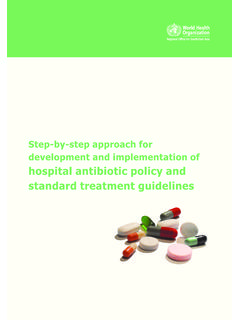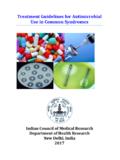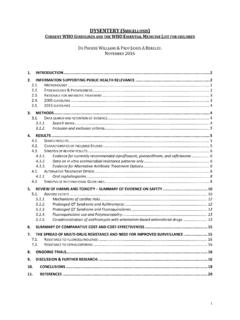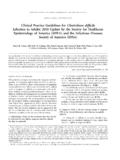Transcription of DRIVERS, DYNAMICS AND EPIDEMIOLOGY OF …
1 DRIVERS, DYNAMICS AND. EPIDEMIOLOGY OF. antimicrobial resistance . IN animal production . DRIVERS, DYNAMICS AND. EPIDEMIOLOGY OF. antimicrobial resistance . IN animal production . Authors: Wall, A. Mateus, L. Marshall and Pfeiffer Co-authors: J. Lubroth, Ormel, P. Otto and A. Patriarchi Food and Agriculture Organization of the United Nations Rome, 2016. Recommended Citation FAO. 2016. Drivers, DYNAMICS and EPIDEMIOLOGY of antimicrobial resistance in animal production Authors Wall, A. Mateus, L. Marshall and Pfeiffer Veterinary EPIDEMIOLOGY , Economics and Public Health Group, Department of production and Population Health, The Royal Veterinary College, North Mymms, London, UK. Co-authors J. Lubroth, Ormel, P. Otto and A. Patriarchi Food and Agriculture Organization of the United Nations, Rome, Italy The designations employed and the presentation of material in this information product do not imply the expression of any opinion whatsoever on the part of the Food and Agriculture Organization of the United Nations (FAO).
2 Concerning the legal or development status of any country, territory, city or area or of its authorities, or concerning the delimitation of its frontiers or boundaries. The mention of specific companies or products of manufacturers, whether or not these have been patented, does not imply that these have been endorsed or recommended by FAO in preference to others of a similar nature that are not mentioned. The views expressed in this information product are those of the author(s) and do not necessarily reflect the views or policies of FAO. ISBN 978-92-5-109441-9. FAO, 2016. FAO encourages the use, reproduction and dissemination of material in this information product. Except where otherwise indicated, material may be copied, downloaded and printed for private study, research and teaching purposes, or for use in non-commercial products or services, provided that appropriate acknowledgement of FAO as the source and copyright holder is given and that FAO's endorsement of users' views, products or services is not implied in any way.
3 All requests for translation and adaptation rights, and for resale and other commercial use rights should be made via or addressed to FAO information products are available on the FAO website ( ). and can be purchased through Drivers, DYNAMICS and EPIDEMIOLOGY of antimicrobial resistance in animal production CONTENTS. Acknowledgements iv Executive summary v Introduction 1. The emergence of antimicrobial resistance in bacteria 3. Evolution of resistance genes 3. Types of resistance : intrinsic versus acquired 5. Mechanisms of bacterial resistance 7. The relevance of animal production in the emergence of antimicrobial resistance 9. Drivers of AMR emergence in animal production 10. Categories of AMU in animal production in relation to the emergence of AMR 11. AMR emergence and AMU within different animal production systems 23.
4 Mechanisms of spread of antimicrobial resistance between animals and humans 28. Local and global mechanisms of spread 28. Relevance and influence of animal production on the spread 33. of antimicrobial resistance Further spread of antimicrobial resistance : can it be stopped? 36. Recommendations 39. References 41. Appendix 1 54. Appendix 2 56. iii Drivers, DYNAMICS and EPIDEMIOLOGY of antimicrobial resistance in animal production ACKNOWLEDGMENTS. The Food and Agriculture Organization of the Unit- The authors would like to thank Sara Babo Mar- ed Nations (FAO) is grateful to the contributors and tins, Katinka deBalogh, Rungtip Chuanchuen, reviewers who lent their advice and expertise to the Samuel Kariuki, Iddya Karunasagar, Robert On- production of this FAO technical paper describing sare, Jorge Pinto Ferreira, Jonathan Rushton, the drivers, DYNAMICS and EPIDEMIOLOGY of antimi- Shabbir Simjee, David Speksnijder, Katharina crobial resistance in animal production .
5 St rk and Jaap Wagenaar for their contributions. In particular, FAO would like to thank the authors The authors are also grateful to Carlos F. Am - Wall, A. Mateus, L Marshall and Pfeiffer bile-Cuevas, Peter Collignon, Jorge O. Errecalde, and the co-authors P. Otto, A. Patriarchi, Ormel Pilar Donado-Godoy, Mark Gersovitz, Christina and Juan Lubroth. Greko, Po-Ren Hsueh, Ramanan Laxminarayan, FAO is also most grateful for the valuable feedback John Mitchell, George William Otim-Nape, Iruka received from the reviewers John Heritage and Sarah *. N. Okeke, Son Radu, Michael P. Reichel, Enrique Cahill . Additionally, FAO shows appreciation to nu- **. Perez Gutierrez, Thomas R. Shryock, Satoru Su- merous colleagues of the FAO interdepartmental Work- zuki, Siddhartha Thakur and Jan Vaarten for their ing Group on antimicrobial resistance (AMR-WG).
6 Guidance and comments. *. University Teaching Fellow and Senior Lecturer in Microbiology School of Molecular and Cellular Biology, University of Leeds, United Kingdom. **. Food Safety Officer, FAO. iv Drivers, DYNAMICS and EPIDEMIOLOGY of antimicrobial resistance in animal production EXECUTIVE SUMMARY. It is now accepted that increased antimicrobial re- detected in organic pig farms in the United States sistance (AMR) in bacteria affecting humans and an- even in the absence of antimicrobial usage (AMU). imals in recent decades is primarily influenced by an In aquaculture, AMR can develop in aquatic and increase in usage of antimicrobials for a variety of fish gut bacteria as a result of antimicrobial therapy purposes, including therapeutic and non-therapeu- or contamination of the aquatic environment with tic uses in animal production .
7 antimicrobial resist- human or animal waste. The extent and persis- ance is an ancient and naturally occurring phenom- tence of antimicrobial residues in aquatic systems enon in bacteria. But the use of antimicrobial drugs is unknown and current evidence is conflicting. in health care, agriculture or industrial settings Furthermore, no international guidelines currently exerts a selection pressure which can favour the exist for maximum antimicrobial residue limits in survival of resistant strains (or genes) over suscep- water. Water is an important vehicle for the spread tible ones, leading to a relative increase in resistant of both antimicrobial residues and resistance de- bacteria within microbial communities. It has been terminants, since contaminated water can be con- observed that, in countries where use of particular sumed directly by humans and livestock and used substances ( fluoroquinolones) is banned in an- to irrigate crops.
8 Imal production , there are low levels of resistance Food is likely to be quantitatively the most im- to these antimicrobials in livestock populations. The portant potential transmission pathway from live- rate of AMR emergence in ecosystems such as the stock to humans, although direct evidence linking human or animal gut is likely to be highly depend- AMR emergence in humans to food consumption ent on the quantity of antimicrobials used, along is lacking. There is a theoretical risk of widespread with the duration and frequency of exposure. In an- dissemination of AMR due to the increasingly global imal production , the prolonged use of antimicrobial nature of food trade and human travel. This would growth promoters (AGPs) at subtherapeutic levels in mean that strains of resistant bacteria could now large groups of livestock is known to encourage re- very quickly reach parts of the world where they had sistance emergence, and is still common practice in previously not been present.
9 Agricultural systems in many countries today. Due to the interdependence emerging economies such as China and India have and interconnectedness of epidemiological path- changed radically in recent years, becoming increas- ways between humans, animals and the environ- ingly intensive in order to meet growing domestic ment, determining the relative importance of factors and global demands for animal protein. This is like- influencing AMR emergence and spread in animal ly to heighten the occurrence and spread of infec- production is a significant challenge, and is likely to tious diseases in these systems, thereby leading to remain one for some time. increased AMU and therefore resistance . In intensive livestock production systems, resist- If the selection pressure resulting from AMU in an- ant bacteria can spread easily between animals and imals and humans were to be removed, this would this can be exacerbated if biosecurity is inadequate.
10 Still not completely halt the emergence and global While some studies have shown reduced levels of spread of AMR due to the ability of AMR genes to AMR on organic farms, a high prevalence of multid- move between bacteria, hosts and environments, rug-resistant (MDR) Campylobacter strains has been and the occurrence of spontaneous mutations. v Drivers, DYNAMICS and EPIDEMIOLOGY of antimicrobial resistance in animal production However, the release of large quantities of an- at present to determine quantitatively how impor- timicrobials or resistant bacteria into the environ- tant the selection pressure of AMU is for the emer- ment is still thought to be an important point for gence of AMR in bacteria. Evidence regarding AMR. control, and therefore measures which encourage transmission pathways between food animals and the prudent use of antimicrobials are likely to be humans is lacking, especially from low- and mid- extremely useful in reducing the emergence and dle-income countries (LMICs).














